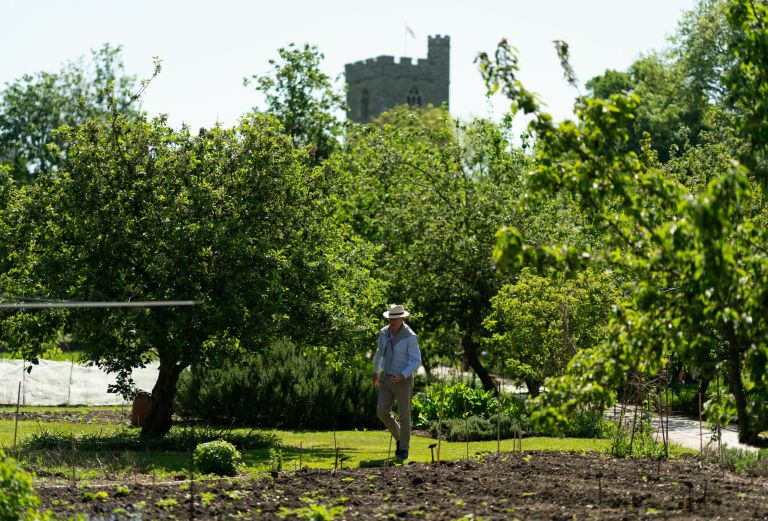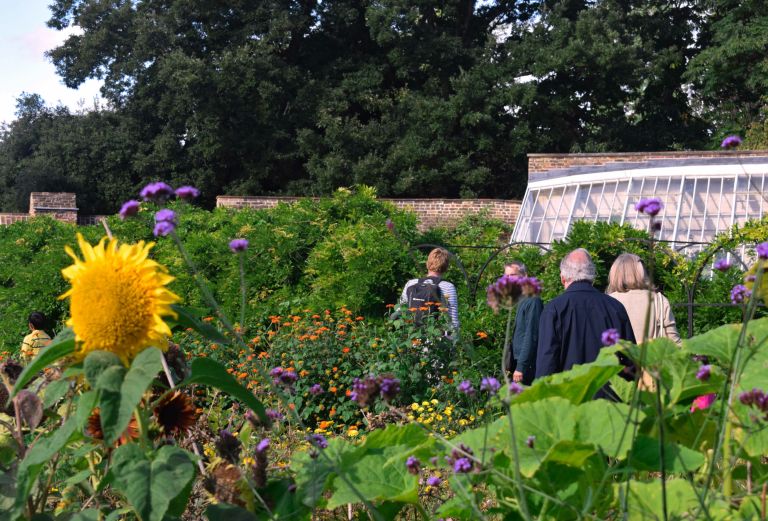Think green for the future
Fulham Palace Trust biodiversity and climate change resilience policy updated for March 2023.
Every day we’re reminded of the ecological and climate emergency that threatens the planet. As custodians of a heritage site, the team at Fulham Palace is more aware than many of the impact of action (and inaction) on a site that is many centuries old. Fulham Palace Trust continues to place carbon reduction and environmental issues at the heart of its work. We all face an ecological and climate emergency that threatens the future of our planet.

For over 1,000 years Fulham Palace has been a green oasis in this corner of west London. The botanical endeavours of various Bishops of London have created stunning gardens and introduced exotic plants species to the country. Today our beautiful garden is open seven days a week, free of charge, enjoyed by all who visit.
It is two years since we launched our biodiversity and climate change policy. This year our focus is on increasing our recycling on-site, reducing energy use, and using green cleaning produced. At the same time we are widening the debate on environmental issues to include the discussion of the decolonisation of horticulture
- Sian Harrington, Chief Executive of Fulham Palace Trust
The 13 acre site of Fulham Palace that you see today is a remnant of a once extensive country estate on the banks of the River Thames, stretching from Chiswick in the west, to Chelsea in the east and up to Willesden in the north. It was owned by the Bishops of London from 704 to 1974 and was his country house from the 14th century.
Over the past 16 years the restoration of Fulham Palace has delivered within this green space a museum, café, shop, education centre, wedding & events venue, residential accommodation and commercial office space. The income we are able to generate from these sources enables the Trust to provide free access to the garden 365 days per annum.
In the garden we have re-introduced plant varieties first grown at the Palace over 300 years ago (many for the first time in the UK and even Europe), established a volunteer-run beekeeping programme, and re-planted the walled garden where we produce organically-grown fruit, flowers and vegetables for sale on our market barrow. Alongside this our learning and engagement programme provides opportunities for involvement for a range of audiences and volunteers. The result is a freely accessible green lung in the heart of London, helping to tackle nature deficit for people living in the city.
The Palace site has many important statutory designations such as scheduled monument status, Grade I & II listed buildings and a Grade II* listed garden. The Palace grounds are part of, alongside Bishop’s Park and All Saints Churchyard, a non-statutory Site of Importance for Nature Conservation (SINC) that is designated of ‘Borough Grade 1’ importance.

We cannot return the site to a past ecology due to the scale of the architectural and landscape interventions by previous Bishops of London over 1,300 years. Furthermore, we must now plan for a resilient future in the light of climate change.
Future plans for developing and supporting the site’s ecology will be based upon available evidence and expert advice from London’s natural history community and urban ecology specialists. These must take account of the site’s various historic and landscape designations.
Fulham Palace Trust is committed to:
- introducing more planting schemes in its gardens which encourage biodiversity
- measuring the local climate at our weather station and informing our visitors about the changes we are seeing in our garden
- encouraging and inspiring visitors, volunteers, staff and tenants to reduce their own pollution and carbon footprint
- reflecting ecology and climate issues in our events programming
- using green electricity and gas tariffs
- using environmental and energy efficiency best practice when managing our estate, and when undertaking restoration and improvement.
In 2023 – 2024 our renewed focus on our buildings and facilities includes:
- changing waste contractors to a company that sends zero waste to landfill, sends all non-recyclable waste to generate green energy, and operates a low emission fleet of vehicles
- replacing halogen lights in the Porteus Library to reduce energy costs and protect our paintings – for which we will be crowdfunding at our 2023 green meet
- refurbishing one of our cottages so that it is completely ‘off-grid’, by providing an air heat source pump and solar panels
- changing the cleaning products used by the housekeeping team. The new products completely eliminate single-use plastics with an on- demand refill service
- reconditioning IT devices rather than buying new, cutting down on WEE waste
- researching the way we use electricity and gas through analysis of usage data at different times of the day and week.
We call on our local community to look at how they can help, at home, and at Fulham Palace. Three small changes can make an impact in a positive way:
- Check with your local authority where you can recycle all waste, including batteries, clothes, electrical items etc.
- start using refillable cleaning products – available from a wide range of suppliers
- save rainwater or ‘grey water’ from washing up to water your plants
- use a reusable cup for hot drinks when on the go (although at the Palace we will compost your cup!)
- use cardboard egg boxes for sowing your own plugs, then you can plant straight out with the egg box cell still intact and the cardboard will rot once replanted.
- put a bug hotel up on a south facing outside wall, fence or balcony to help beneficial insects such as ladybirds, lacewings and hoverflies through the winter
- if you have a lawn, allow a patch of grass to grow long and leave it uncut until the following June. This will help overwintering insects to remerge successfully.

This declaration follows a number of changes the Palace has made to green its working practices.
Some of the initiatives already put in place include:
- we have planted over 120 fruit trees (apples, pears, peaches, almonds) in the walled garden since 2012
- we have installed a water collecting tank which we use to water plants in the walled garden
- we have put in dead hedges to create a habitat for small mammals and other wildlife when we have surplus woody garden waste – rather than burning or skipping
- we use brushwood to stake our perennial plants using sustainable coppices hazel from the site
- we have created special Palace mixes of grassland plants that fit the history of the Palace with the aim of creating resilience against future climate change
- takeaway cups, plates and cutlery in the café are biodegradable and are now composted by the garden team alongside coffee grounds, fruit and vegetable waste from the café
- we have been running an Apple Day for 7 years, highlighting the traditional celebration of the harvest and focussing on our home grown apples and honey
- we are reconditioning IT devices whenever possible rather than buying new, cutting down on WEE waste, the use of rare raw materials necessary for most IT devices and contributing to the circular economy ethos.
Going forward we are making the following commitments:
- to hold an annual fair to mark Earth Day (this year’s event will take place on 30 April) and continue to develop our Apple Day message of seasonality and food miles
- we pursue our action plan for long term habitat management. This will include supporting natural regeneration and, where suitable, planting environmentally resilient and ecologically suitable plantings as well as other measures to support biodiversity.
- we will continue to monitor developments in the garden machinery market and introduce battery powered equipment as it becomes proven technology
- we will continue to put up more bird boxes and bat boxes
- we will produce a long term tree planting and natural regeneration plan to ensure that we have different age cohorts of trees and that we are managing our tree stock with the long term aim of supporting biodiversity and that fits the history of the Palace.
- we will support trees in crisis such as ash and elm, allowing them to grow in the hope that some will have resistance to disease, and if they die, we will use their trunks for log piles and create greater habitat diversity.
- we will engage a wider range of visitors and community groups to access the Palace and the work we are doing in the areas of biodiversity and climate change though workshops and talks
- we will investigate the longer term possibility of re-introducing water into the moat which will provide opportunities for water habitats
- we will consider green energy such as ground heat source pumps and solar panels when refurbishing or building on site, subject to planning and scheduled ancient monument restrictions.
- we will improve recycling and processing of food waste generated by weddings, café and tenants on site.

-ENDS-
Notes to the editors
Entry to Fulham Palace is free
Further information and press images
Erin Brudi, marketing executive | 020 7610 7163 | erin.brudi@fulhampalace.org
Mercy Fowler, marketing assistant | 020 7610 7165 | mercy.fowler@fulhampalace.org
About Fulham Palace
Fulham Palace is the historic home of the Bishops of London. Purchased in AD 704, for centuries the Palace and surrounding estate served as a country retreat for the bishops and their families before becoming the Bishop’s permanent residence in the early 20th century until the last Bishop moved out in 1973. The Palace and 13 acre botanic garden are now managed by Fulham Palace Trust, an independent charity dedicated to the ongoing preservation, restoration and interpretation of this historically important site.